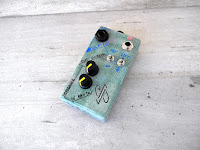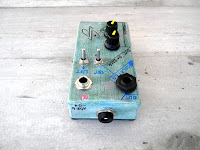Break Ground Loops, avoid Hum noise, choose input/output impedance.
This small isolator is used for eliminating hum caused by ground loops and is suitable both for bass & guitar or any other instrument with similar pickups but it can also be used for line level signals.
In case you have a ground loop you want to break (e.g. when using two amps simultaneously) simply connect this isolator in the right place and this will eliminate the hum. The isolation is achieved with the use of an audio transformer with flat response, (20Hz-20kHz) and it’s activated when you flip the toggle switch to the GROUND LIFT position.
A phase reverse switch is also available in case you have phasing problem in your setup and it can be very handy when using multiple amps simultaneously.
In case you have a ground loop you want to break (e.g. when using two amps simultaneously) simply connect this isolator in the right place and this will eliminate the hum. The isolation is achieved with the use of an audio transformer with flat response, (20Hz-20kHz) and it’s activated when you flip the toggle switch to the GROUND LIFT position.
A phase reverse switch is also available in case you have phasing problem in your setup and it can be very handy when using multiple amps simultaneously.
The device also offers you the ability to vary the input & output impedance of the circuit in order to tune it according to your needs and according to the devices you have in your setup. The effect of these knobs depends on the devices that are connected before and after the isolator.
The input & output impedance knobs help you adjust the way that your instrument interacts with the pedals that follow or even change the way your effects interact with each other. The impedance changer circuit is actually a sort of variable "buffer" with two potentiometers that give you the ability to select the input & output impedance of the circuit.
Lots of effects that are available in the market (e.g. vintage designs, older fuzzes, treble boosters, circuits with germanium transistors etc) have a quite low input impedance and that's what gives them their distinctive character. But this character and their "behavior" changes (often getting worse) if you change your instrument (e.g. from passive to active) or if you have a non-true-bypass, buffered pedal connected in front of it. That’s where the impedance knobs offer you a solution.
You can experiment and see how every pedal responds with different impedance values. The IN-knob changes the way the signal is picked up from the input and the OUT-knob changes the way the signal is picked up by the next pedal in the chain.
Quick Tips:
- Depending on the instrument (or pedal) you connect in front of the isolator you may notice a different behavior of the IN-knob, usually being more effective after the “12:00” position.
- As the IN-knob gets closer to the 1k position a volume drop is to be expected.
- When IN-knob is set at "1M" and OUT-knob set at "0ohm" the pedal works as a buffer. (High input impedance, Low output impedance)
- When you connect a pedal to the device's OUTPUT the lower the pedal’s input impedance is the more drastic the OUT-knob will be.
▹ Output impedance range: 0 ~ 220kΩ
▹ When Isolation is ON the output can be connected to either a balanced or an unbalanced device.
▹ Frequency response: flat @ 20Hz-20kHz
▹ Voltage Required: DC 9-24V (Use 12-24V if you need more headroom)
[Do not exceed recommended voltage! It may damage the circuit.]
▹ Polarity: Center Negative
▹ Current Draw: 4mA @ 9V
▹ Weight: ~140 gr
▹ Enclosure dimensions: 114x60x32mm (4.43x2.38x1.22in)












